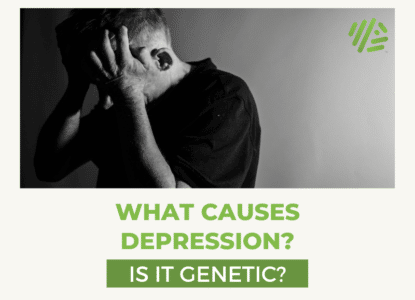Bryan Johnson’s Gene Therapy: Is it Worth it?
Article at a Glance
- Bryan Johnson underwent an experimental $25,000 gene therapy in Honduras to increase levels of follistatin, a protein that may enhance muscle growth and reduce inflammation, with the hope of improving longevity as part of his “Don’t Die” campaign.
- While early results show modest benefits like reduced body fat and biological age markers, the therapy lacks rigorous clinical validation, peer review, and long-term safety data—making it an intriguing but premature option for most people

Contents
You may have heard that multimillionaire and anti-ageing enthusiast Bryan Johnson travelled to Roatan island in Honduras to receive an experimental gene therapy for enhancing his life and health span (price tag: $25,000).
Here, we’ll discuss what is known about this therapy, what evidence we have for it working and if it is worth the price, the trip and the potential risks.
Follistatin: The Delivered Gene
The gene Bryan paid to boost in his body is called follistatin. Follistatin is a small secreted glycoprotein, which is broadly expressed across multiple organs and tissues. Its expression is further increased in response to physiological stress, inflammation, and tissue injury.
Follistatin binds to and neutralizes members of the Transforming Growth Factor Beta (TGF-β) superfamily—particularly Activin A and myostatin—many of which are activated during stress and inflammation. Activin A is a regulator of inflammation, while myostatin is a suppressor of muscle growth. By antagonizing these signalling molecules, follistatin helps reduce inflammation and limit muscle wasting.
Follistatin Isoforms: A Quick Overview
Follistatin has two isoforms, one of which (315 amino acids long, FST-315) is produced mainly by liver and muscle cells and has global effects. The other one (288 amino acids long, FST-288) is less soluble and doesn’t spread around the body well. It is produced by various organs, particularly when there’s a need–for example, to modulate inflammation.

Get Started With Personalized Nutrition
Gene Food uses a proprietary algorithm to divide people into one of twenty diet types based on genetics. We score for cholesterol and sterol hyperabsorption, MTHFR status, histamine clearance, carbohydrate tolerance, and more. Where do you fit?
Follistatin for Longevity
The idea for using follistatin for longevity comes from work in mice, showing that delivering this gene increases their lifespan by nearly a third, importantly without increasing the incidence of cancer that is often a risk with rejuvenating treatments (R).
In addition, delivering follistatin to both mice and non-human primates led to increased muscle size and strength (R)(R).
Previous studies in humans were limited to small, open-label trials for people with various types of muscular dystrophy, showing promising results (R).
However, to our knowledge, these were not yet followed up by larger, randomised trials.
Why Use Gene Therapy for Follistatin?
It is expected that the effects of follistatin would take a while to show and can wane quickly if discontinued–particularly in the context of longevity. In theory, follistatin could also be injected regularly, like insulin. However, unlike insulin, it may not need to be regulated so tightly, and there is hope that simply increasing its baseline concentration may be helpful. Therefore, instead of injecting the protein itself long-term at regular intervals, the idea is to inject the instructions for making it and let the cells get on with it. Gene therapy also solves the issue with two FTS isoforms by providing the instructions to make both (in the form of a gene coding for a 344 amino-acid precursor) and letting them decide.
In principle, gene therapy for follistatin is a great idea, assuming increasing its concentration in the body is indeed helpful and the cells that can make it in correct amounts can be reached with a given gene therapy approach. Getting the cells to express a gene short-term is a low-risk task that has gone mainstream with the advent of RNA vaccines. Teaching our bodies to express a gene long-term reliably and safely has, however, been a bumpier road–but currently, several strategies exist that have proven useful. For expression in muscle, scientists typically load the gene into a modified Adeno-Associated Virus that doesn’t integrate into the genome but can stay in the cells for a long time in the form of an extra mini-chromosome known as ‘episome’. Other gene delivery strategies are continuously developed, including for follistatin by the company used by Johnson (https://minicircle.io/) and others (https://doi.org/10.1016/j.cell.2024.07.023)
The approach used by Johnson
The approach has been registered as a Phase 1 clinical trial, and mildly encouraging results have been reported in a preprint (R).
The key findings are that:
- Gene therapy has increased the follistatin concentration about 2-fold
- There was a significant reduction of body fat
- A DNA methylation-based marker of ageing, Extrinsic Epigenetic Age, decreased significantly
There are, however, a few caveats to these conclusions:
(a) The study’s protocol has not undergone rigorous validation and ethical approval. Although the startup developing this therapy, Minicircle, is based in the US, injections into humans were performed in a free economic zone in Honduras, and the preprint mentions that approval has been done through an unspecified review board of the GARM clinic performing the injections.
(b) The study results have not been peer-reviewed. The company presented the results in a preprint but has not yet been published in any peer-reviewed journal. While peer review doesn’t guarantee a study’s quality, lack of peer-reviewed publication in a reputable journal means that the results should be treated at best as preliminary.
(c) The results are from a small, short-term, single-arm study. The data presented are for 43 individuals of a broad age distribution (23-88), assessed only over 3 months, without a placebo control group to compare the results against (let alone any kind of randomisation/blinding). This may be just about OK for a Phase 1 trial focused on safety. But to demonstrate efficacy, a larger, well-controlled and longer-term trial is necessary. What if, for example, people who received the treatment subconsciously switched to a healthier lifestyle for a while, without even noticing this? A placebo-controlled, randomised experiment would rule out the potential effects of that behavioural change. And what if the effects of gene therapy are only short-lasting and the results return to normal after a few months? For longevity purposes, this effect may not be meaningful.
(d) The safety and efficacy of the gene therapy vector are not presented. The authors mention that they developed a proprietary system for gene delivery that is different from AAV. Information about this system is scarce on the Minicircle website, but it seems to be based on delivering the DNA directly in the form of a plasmid, avoiding the use of viral vectors. In principle, this is a promising route. However, it requires some tricks to work (or else there would be no need for viral vectors!) and its safety and efficacy remain to be demonstrated formally.
(e) Evidence for the longevity effects of this treatment in humans remains scarce. It is still unclear whether the observed two-fold increase in follistatin concentration, even if lasting, increases lifespan and/or health span in humans. Beyond studies in mice using a different form of follistatin gene delivery (based on a viral vector), the key evidence in humans is the reduction of one kind of epigenetic age after 3 months reported in the preprint. While this result is potentially encouraging, it is not definitive.
Our verdict: Is It Worth it?
In our view, not yet. This therapy is not approved in most countries, is expensive, and evidence for its efficacy and safety remains limited. While the data reported in the preprint may be encouraging, larger, well-controlled and longer-term studies are required to prove the efficacy of this treatment and understand its risks.



